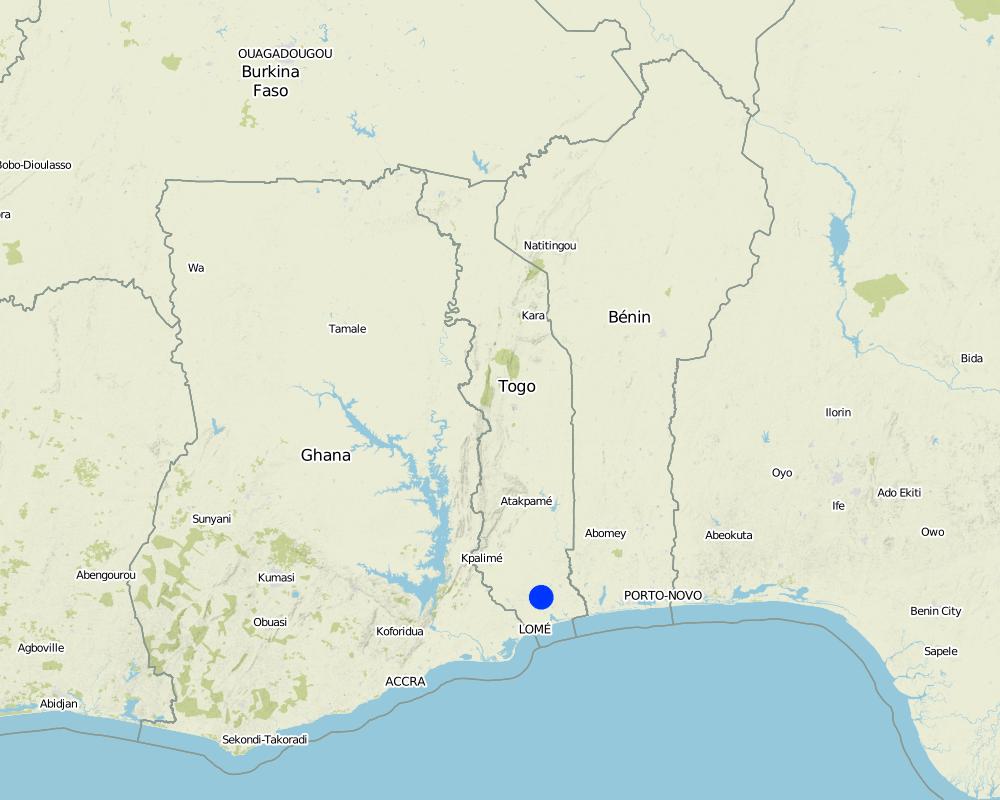New SLM Approach [Togo]
- Creation:
- Update:
- Compiler: Philippe Zahner
- Editor: –
- Reviewer: Fabian Ottiger
approaches_2641 - Togo
View sections
Expand all Collapse all1. General information
1.2 Contact details of resource persons and institutions involved in the assessment and documentation of the Approach
Name of the institution(s) which facilitated the documentation/ evaluation of the Approach (if relevant)
Swiss Agency for Development and Cooperation (DEZA / COSUDE / DDC / SDC) - Switzerland1.3 Conditions regarding the use of data documented through WOCAT
The compiler and key resource person(s) accept the conditions regarding the use of data documented through WOCAT:
Ja
2. Description of the SLM Approach
2.5 Country/ region/ locations where the Approach has been applied
Country:
Togo
Region/ State/ Province:
Maritime
Map
×2.9 Conditions enabling or hindering implementation of the Technology/ Technologies applied under the Approach
legal framework (land tenure, land and water use rights)
- enabling
The existing land ownership, land use rights / water rights greatly helped the approach implementation: les exploitants ??taient propri??taires de leurs acquises par achat
3. Participation and roles of stakeholders involved
3.1 Stakeholders involved in the Approach and their roles
- local land users/ local communities
Men are the human groups that are more interested in agriculture. Retirement, man seeks his safety? Financial operation in land use contrary to wife
3.2 Involvement of local land users/ local communities in the different phases of the Approach
| Involvement of local land users/ local communities | Specify who was involved and describe activities | |
|---|---|---|
| initiation/ motivation | interactive | Workshops / seminars; They have a less precise idea of technology and the specialist helps them to clarify it |
| planning | interactive | Method of access to participatory research |
| implementation | interactive | responsibility at minor stages; The operators execute the plan and the program of the activities under the supervision of the specialists |
| monitoring/ evaluation | none | |
| Research | none |
4. Technical support, capacity building, and knowledge management
4.1 Capacity building/ training
Was training provided to land users/ other stakeholders?
Ja
Subjects covered:
Corridor cultivation and windbreaks, planting techniques and hedge management
4.2 Advisory service
Do land users have access to an advisory service?
Ja
Describe/ comments:
Advisory services are very adequate to ensure the continuation of land conservation activities; Resources is available at ITRA, ICAT, to pay the Supervision of Operators
4.3 Institution strengthening (organizational development)
Have institutions been established or strengthened through the Approach?
- yes, a little
Specify the level(s) at which institutions have been strengthened or established:
- local
4.4 Monitoring and evaluation
Is monitoring and evaluation part of the Approach?
Ja
Comments:
bio-physical aspects were ad hoc monitored through observations
technical aspects were ad hoc monitored through observations
economic / production aspects were regular monitored through measurements
There were no changes in the Approach as a result of monitoring and evaluation
4.5 Research
Was research part of the Approach?
Ja
Give further details and indicate who did the research:
Technical improvements are constantly sought and the market conditions are also studied
5. Financing and external material support
5.2 Financial/ material support provided to land users
Did land users receive financial/ material support for implementing the Technology/ Technologies?
Nee
5.3 Subsidies for specific inputs (including labour)
If labour by land users was a substantial input, was it:
- voluntary
Comments:
The operators themselves solicit specialists
5.4 Credit
Was credit provided under the Approach for SLM activities?
Nee
6. Impact analysis and concluding statements
6.1 Impacts of the Approach
Did the Approach help land users to implement and maintain SLM Technologies?
- No
- Yes, little
- Yes, moderately
- Yes, greatly
am??lioration de la fertilit?? des sols, de sa capacit?? de retention d'eau
Did other land users / projects adopt the Approach?
- No
- Yes, little
- Yes, moderately
- Yes, greatly
les exploitants qui d??couvrent la technologie mise en place et l'approche qui lui est associ??e sont int??ress??s et l'adoptent aussi
6.4 Strengths/ advantages of the Approach
| Strengths/ advantages/ opportunities in the land user’s view |
|---|
| 1) am??lioration des connaissances techniques et ??conomiques (How to sustain/ enhance this strength: continuer la formation avec lui) |
| 2) am??lioration des rendements de culture (How to sustain/ enhance this strength: lui fournir des docuements de gestion technique des cultures) |
| Strengths/ advantages/ opportunities in the compiler’s or other key resource person’s view |
|---|
| 1) responsabilisation des exploitants (How to sustain/ enhance this strength: lui confier beaucoup plus d'ex??cution des plans d'action) |
| 2) am??lioration des connaissances agro-??conomiques de l'exploitant (How to sustain/ enhance this strength: renforcer la formation en fonction du niveau intellectuel des exploitants) |
| 3) cr??ation de lien de confiance entre l'exploitant et vulgarisateur (How to sustain/ enhance this strength: montrer ?? l'exploitant le bien fonc?? de l'approche) |
6.5 Weaknesses/ disadvantages of the Approach and ways of overcoming them
| Weaknesses/ disadvantages/ risks in the compiler’s or other key resource person’s view | How can they be overcome? |
|---|---|
| difficile ?? appliquer si l'exploitant n'est pas instruit | essayer la formation en langue locale |
7. References and links
7.1 Methods/ sources of information
- field visits, field surveys
- interviews with land users
Links and modules
Expand all Collapse allLinks
No links
Modules
No modules


